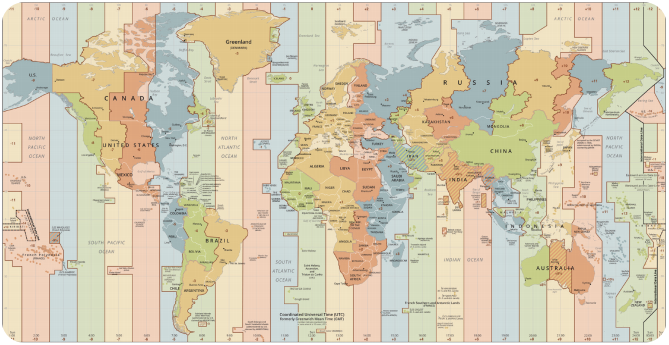Time Zones
The sun rises at different times in different places on Earth. For practical use, it proves to be appropriate to introduce a time that would reflect the different position of the place on Earth. The solution is to introduce a time zone system.
Time Zones
The basis for the introduction of the time zone system as we know it is the idea that if we move 15 degrees east on Earth (we neglect the polar regions), the sun will rise 1 hour earlier. This can be proved by a simple calculation: 360 degrees corresponds to 24 hours, so 15 degrees means a difference of 1 hour. Therefore, if we use meridians with a longitude equal to a multiple of 15 degrees, we get a network of meridians on Earth, in which the mean solar time will be shifted by multiples of hours relative to UTC. However, the above-mentioned rough division of the Earth's surface into individual strips is not entirely optimal, especially with regard to the borders of individual states. With the exception of huge countries such as Russia, Australia or the USA, it is appropriate for one time zone to apply in a given state, or even for the same time zone to apply in geographically close countries. Therefore, the time zone map given above is much more varied than what would correspond to the strict application of the meridian bands. We can also register time zones on the map that differ from UTC by an integral number of hours.

(Source: https://commons.wikimedia.org/wiki/File:World_Time_Zones_Map.png)
Central European Time is the time corresponding to the meridian of the 15th degree of eastern longitude, which passes, for example, Pacov. As we already know, in places east of this meridian the sun rises earlier, in places west of this meridian on the contrary later. Each degree of latitude means a shift of 4 minutes (15 degrees of latitude corresponds to 1 hour, or 60 minutes, so 1 degree corresponds to 4 minutes). The difference between the latitudes of the easternmost and westernmost place in the Slovak Republic is less than 7 degrees, the difference between sunrises (and sunsets) is about 27 minutes on the same day.


